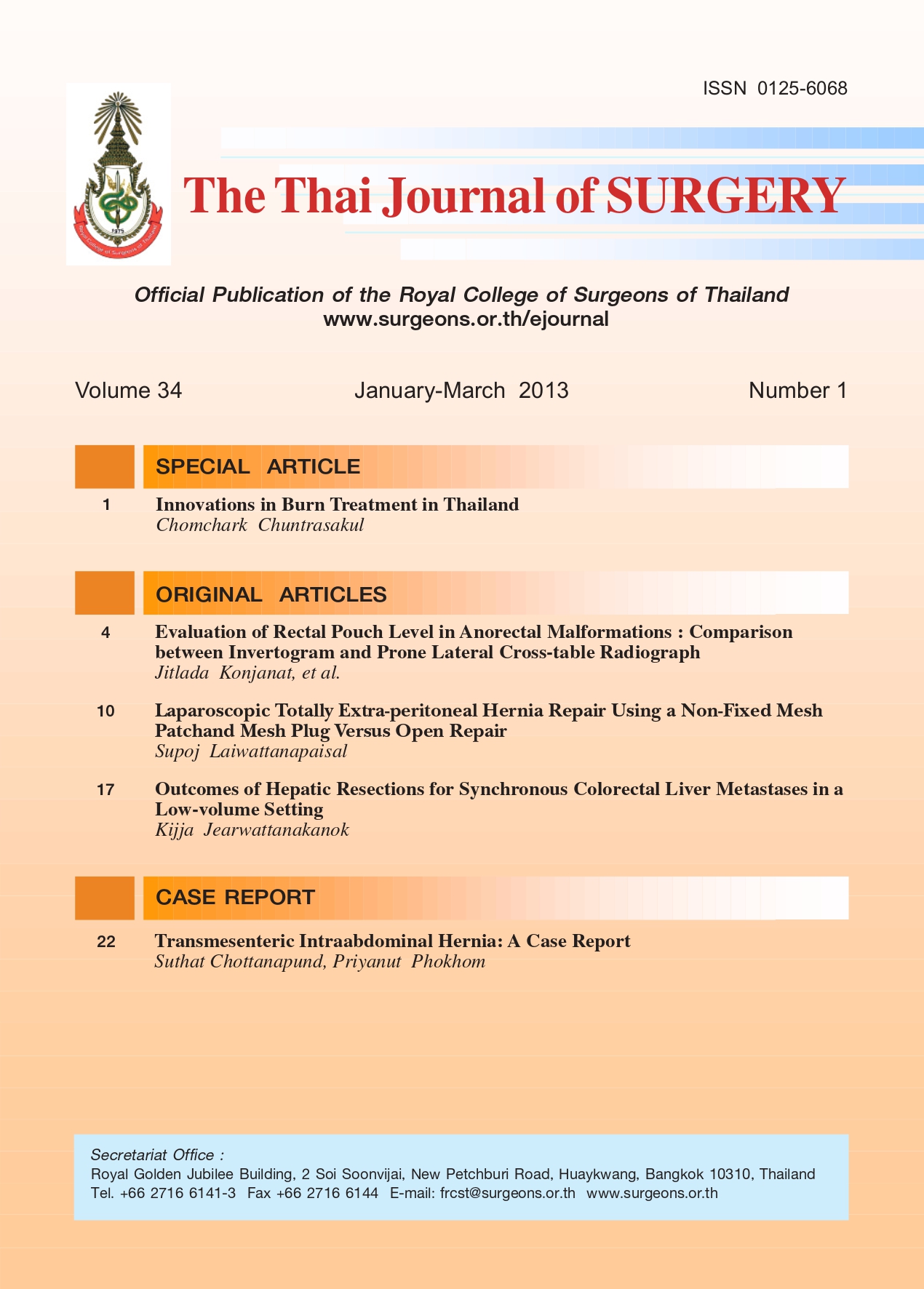Laparoscopic Totally Extra-peritoneal Hernia Repair Using a Non-Fixed Mesh Patchand Mesh Plug Versus Open Repair
Keywords:
extra-peritoneal repair, inguinal hernia, laparoscopic herniorrhaphyAbstract
Objective: To determine post-operative outcomes after laparoscopic totally extra-peritoneal hernia repairusing a non-fixed mesh patch and mesh plug, compared with open repair.
Material and Method: We retrospectively studied the cases of 70 patients who all underwent hernia repair
surgery using either laparoscopic TEP or an open repair technique, performed by a single surgeon (the author). All
cases took place between May 18, 2008 and April 30, 2010. Patient characteristics including gender, age, hernia type
classification, pain score, operative time, recovery time, recurrence rate and any complications was obtained by
reviewing each patient’s medical record.
Results: Thirty patients underwent laparoscopic TEP with non-fixed mesh, and 40 patients underwent open
repair. Mean patient age was 49.6 ± 16.1 years in the TEP group and 47.8 ± 15.9 years in the open repair group (P
= 0.632). Patients in the TEP group suffered from indirect hernias (73.3%), direct hernias (20%) or combined
hernias (6.7%). Patients in the open repair group had indirect hernias (90%) or direct hernias(10%). The mean
operative time was147.3 ± 33.5 minutes in the TEP group and 43.8 ± 10.8 minutes in the open repair group (P < 0.001).
Pain scores within 24 hours of the procedures averaged 3.5 ± 2.1 in the TEP group and 5.9 ± 2.9 in the open repair
group (P < 0.001). Mean hospital stay was 5.6 ± 0.77 days in the TEP group and 3.5 ± 1.8 days in the open repair group
(P < 0.001). The follow-up period averaged 29.8 ± 4.2 months in the TEP group and 36.3 ± 3.2 months in the open
repair group(P < 0.001). No recurrences were reported in either group. Common complications included minor
morbidities such as seroma, urinary retention, chronic groin pain, epididymitis, and subcutaneous emphysema,
which were not significantly different between groups.
Conclusions: Although the operative time for the laparoscopic TEP method was longer and resulted in a longer
hospital stay, we demonstrated that it can be performed safely, with only minor complications and with no recurrence.
References
after laparoscopic (TEP) and open (Lichtenstein) inguinal
hernia repair: a randomized, multicenter trial with 5-year
follow-up. Ann Surg 2009;250:354-5.
2. Wake BL, McCormack K, Fraser C, Vale L, Perez J, Grant AM.
Transabdominal pre-peritoneal (TAPP) vs totally
extraperitoneal (TEP) laparoscopic techniques for inguinal
hernia repair. Cochrane Database Syst Rev 2005(1):
CD004703.
3. Tam KW, Liang HH, Chai CY. Outcomes of staple fixation of
mesh versus nonfixation in laparoscopic total extraperitoneal
inguinal repair: a meta-analysis of randomized controlled
trials. World J Surg 2010;34:3065-74.
4. Sajid MS, Ladwa N, Kalra L, Hutson K, Sains P, Baig MK. A
meta-analysis examining the use of tacker fixation versus
no-fixation of mesh in laparoscopic inguinal hernia repair.
Int J Surg 2012;10:224-31.
5. Deans GT, Wilson MS, Royston CM, Brough WA. Recurrent
inguinal hernia after laparoscopic repair: possible cause
and prevention. Br J Surg 1995;82:539-41.
6. Felix E, Scott S, Crafton B, Geis P, Duncan T, Sewell R, et al.
Causes of recurrence after laparoscopic hernioplasty. A
multicenter study. Surg Endosc 1998;12:226-31.
7. Stark E, Oestreich K, Wendl K, Rumstadt B, Hagmuller E.
Nerve irritation after laparoscopic hernia repair. Surg
Endosc 1999;13:878-81.
8. Lantis JC, 2nd, Schwaitzberg SD. Tack entrapment of the
ilioinguinal nerve during laparoscopic hernia repair. J
Laparoendosc Adv Surg Tech A 1999;9:285-9.
9. Sherman V, Macho JR, Brunicardi FC. Inguinal hernia. In:
Brunicardi FC, editors. Schwartz’s Principles of Surgery. 9th
ed. New York: McGraw-Hill; 2009. p. 1305-42.
10. Myers E, Browne KM, Kavanagh DO, Hurley M. Laparoscopic
(TEP) versus Lichtenstein inguinal hernia repair: a comparison
of quality-of-life outcomes. World J Surg 2010;34:3059-64.
11. Lowham AS, Filipi CJ, Fitzgibbons Jr RJ, Stoppa R, Wantz GE,
Felix EL, et al. Mechanisms of hernia recurrence after
preperitoneal mesh repair: traditional and laparoscopic.
Ann Surg 1997;225:422-31.
12. Davis CJ, Arregui ME. Laparoscopic repair for groin hernias.
Surg Clin North Am 2003;83:1141-61.
13. Voyles CR, Hamilton BJ, Johnson WD, Kano N. Meta-analysis
of laparoscopic inguinal hernia trials favors open hernia
repair with preperitoneal mesh prosthesis. Am J Surg
2002;184:6-10.
14. Treepongkaruna SA, Subwongcharoen S. Novel technique
of mesh fixation with cyanoacrylate in totally extraperitoneal
laparoscopic hernia repair: early experience. J Med Assoc
Thai 2012;95 (Suppl 3):S98-101.
15. Voitk AJ. The learning curve in laparoscopic inguinal hernia
repair for the community general surgeon. Can J Surg
1998;41:446-50.
16. Jongsiri N. A 9-year Experience of Laparoscopic
Herniorrhaphy at FortPrajaksilapakom Hospital. Thai J Surg
2009;30:42-6.
17. Luangchna V. Laparoscopic repair of inguinal hernia using
two layers of mesh with reinforcement of the inner mesh by
2 sutures. J Med Assoc Thai 2004;87:1425-30.
18. Choi YY, Han SW, Bae SH, Kim SY, Hur KY, Kang GH.
Comparison of the outcomes between laparoscopic totally
extraperitoneal repair and prolene hernia system for inguinal
hernia; review of one surgeon’s experience. J Korean Surg
Soc 2012;82:40-4.
19. Neumayer L, Giobbie-Hurder A, Jonasson O, Fitzgibbons Jr
R, Dunlop D, Gibbs J, et al. Open mesh versus laparoscopic
mesh repair of inguinal hernia. N Engl J Med 2004;350:1819-
27.
20. Vidovié D, Kirac I, Glavan E, Filipovic'-Cugura J, Ledinsky M,
Bekavac-Beslin M. Laparoscopic totally extraperitoneal
hernia repair versus open Lichtenstein hernia repair:
resultsand complications. J Laparoendosc Adv Surg Tech A
2007;17:585-90.
21. Khoury N. A randomized prospective controlled trial of
laparoscopic extraperitoneal hernia repair and mesh-plug
hernioplasty: a study of 315 cases. J Laparoendosc Adv Surg
Tech A 1998;8:367-72.
22. Chung RS, Rowland DY. Meta-analyses of randomized
controlled trials of laparoscopic vs conventional inguinal
hernia repairs. Surg Endosc 1999;13:689-94.
Downloads
Published
How to Cite
Issue
Section
License
Articles must be contributed solely to The Thai Journal of Surgery and when published become the property of the Royal College of Surgeons of Thailand. The Royal College of Surgeons of Thailand reserves copyright on all published materials and such materials may not be reproduced in any form without the written permission.



